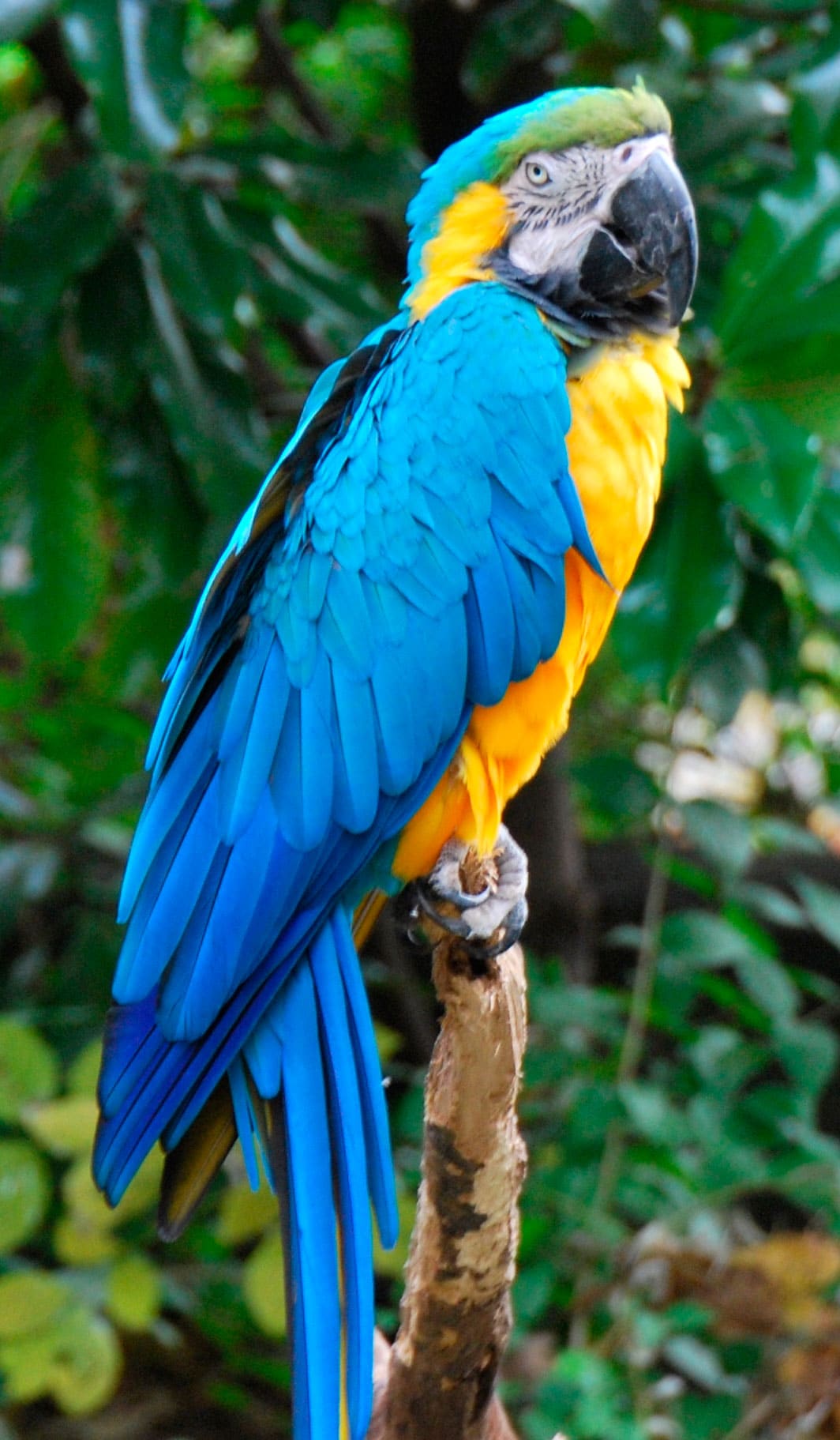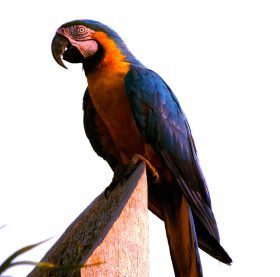Content |
|---|
Description:
Of 86 cm.. length and a weight between 995 and 1380 g..
The Blue-and-yellow Macaw (Ara ararauna) has the forecrown and both sides of the head to behind eyes bright green, faded to bright ultramarine blue in the crown and nape.
The upperparts Blue bright overseas. Upper wing coverts Blue bright overseas; flight feather Violet Blue top, Yellow Gold to olive brown down; Depending on the light, the underwing-coverts, yellow.
Large patch yellow on the sides of the neck and ear-coverts edged ahead by a black stripe, to expand to form a black patch in the throat.
Undertail-coverts blue. Uppertail dark purple suffusion overseas; undertail, the tail golden yellow to olive brown depending on the light; Tips new feather of the tail striped wide.
Bill dark grey; cere naked and facial patch (including lores and cheeks to behind eyes) white crossed by narrow lines of feathers Black in knowledge and cheeks top (the skin of the face pink when they are excited); irises pale yellow; legs dark grey.
Both sexes similar.
The youth they have the wings and tail Cafe-grisacea and eyes browns.
- Sound of the Blue-and-yellow Macaw.
Habitat:
They inhabit areas with large trees, often near water, including moist lowland forest edges (mostly forests and marshes, avoiding the lowland forest of tierra firme), gallery forest in the savannah, Savannah with trees and scattered Palms, marshy forests and swampy areas with Palm trees (Mauritia flexuosa). As well bosque deciduous away from the water in Colombia and Panama.
They sometimes feed in more open areas, posing on the floor, for example, for feeding of fruits of Palm.
Gregarious. Usually, observed in pairs, family groups or flocks of up to 25 birds (sometimes many more, especially near the roosts).
The Blue-and-yellow Macaw are observed more often in the morning and afternoon, halfway between the roosts and feeding areas.
Communal roosts in the trees.
Reproduction:
Son monogamous and they usually form a couple throughout their lives.
It nests in a hole in the top of a dead Palm tree (for example, Mauritia flexuosa).
Breeding between the months of February and March in Suriname; Between January and may in Trinidad (formerly); Between December and February in Colombia (birds observed in breeding conditions). Egg laying observed in February in Guyana and between November and January at Peru.
The laying, generally, is two or three eggs, incubated by the female for a few 28 days, the chicks leave the nest to the 90 days after birth.
Food:
They feed on a wide variety of locally available fruits (mostly from various Palm trees), nuts, Spring sprouts, etc., elements reported including fruits of Astrocaryum, Mauritia and palms Acrocomia, seeds of platypodium grandiflorum, Sloanea, Brosimum, Were, Spondias, Inga, Parkia, Hura crepitans and Enterolobium, nectar Combretum laxum and aril of Hymenaea Courbaril.
The Blue-and-yellow Macaw they eat quietly at the top of the canopy, often near clearings. Large flocks may congregate in areas of ribera, often with other species of parrots, to supplement their diet with minerals that are ncuentran in clayey soils.
Distribution:
Its distribution is varied and discontinuous: east of Panama and the tropical lowlands of South America to the South-East of Brazil, Bolivia and Paraguay.
In Panama, from the top of the bayano river (Maybe just once) to the East of Darien mainly in the drainage of the Tuira River and the Chucunaque River.
Along the lower tropics (some 500 m) in Colombia; apparently absent from the Valle del Cauca, Nariño, and the moist rain forests of central Choco.
In the eastern lowlands of Ecuador, and perhaps earlier in Guayas, on the slope of the peaceful.
Tropical zone of Venezuela, mainly to the South of the Orinoco, in Monagas only in the north shore (for example in the drainage of the amana river).
extinct in Trinidad from 1970; escapes of captive birds reported since.
Spread sheets and coastal river systems of Guyanas and Suriname.
Widespread in Brazil, but extinct in Bay, South of Rio de Janeiro and in Santa Catarina, during the years 1950 or 1960; they remain in the southeast of Brazil only in the State of São Paulo Western, as a wandering bird from populations further to the West in the region of the Pantanal and the lowlands of Bolivia and Peru.
Current situation in the Paraguay (probably Northeast, perhaps earlier in the South) It is not clear.
The records of Argentina remain corroborated.
Resident general, but with some movements of foraging season.
Locally common, but, apparently, decrease in Panama.
Fairly common in less disturbed areas of Colombia.
Scarce, irregular and decreasing to the West of the Andes in Colombia and Ecuador.
Local in Venezuela.
The largest population of the Blue-and-yellow Macaw It is located in the coastal area of Suriname and it appears to be very common in northwestern Guyana, much less numerous in the South; local in the French Guayana due to the persecution. More common in parts of Brazil (especially in the Amazonia), but rarer in Pantanal. Locally common in the Amazon area of Peru but with a drastic drop around the main capture centers (for example, Iquitos and Pucallpa).
Apparently rare Bolivia, in the Northwest area, but common (at least locally) in the East.
In the 15th century and probably until the end of the 19th century its distribution area encompassed virtually all the the Caribbean basin.
Conservation:
• Current Red List of UICN: Least concern
• Population trend: Decreasing
The size of the world's population has not been quantified, but this species is described as ‘Rare‘ (Stotz et to the. 1996).
Not regarded as threatened, Although it is appreciated as bird cage, and their populations are declining and several are now extinct, including the of Trinidad.
The species has undergone intense trade: from 1981, When it began trading in the Appendix II of CITES, 55,531 individuals captured in nature have been registered in international trade (UNEP-WCMC CITES Trade Database, January 2005).
An investigation by the UN indicates that removal of chicks of Blue-and-yellow Macaw, in the Amazon, exceeds the 26%, which leads to overexploitation of the species.
“If a stock is already being overexploited, any rate and type of extraction would have serious effects on its viability and could quickly drive it to extinction. The extraction of adults, even in healthy populations, is even more critical as a rate of 3% already produces population declines, and if they are being subjected simultaneously to extraction of chicks and adults, hunting rates must not exceed the 1% or 2% so that there is no risk of extinction”, Esteban Carrillo and Diego Fernando Builes doors explained, authors of research.
The genera Amazon (Loras) and Ara (macaws) they are particularly vulnerable, due to factors such as its low reproductive rates, low survival of chicks, late age of first breeding, large proportion of non-breeding adults and specific requirements for nest building. In addition are the two most desired genera as pets, and whose extraction generates greater economic “profits” for local hunters.
In particular, the Blue-and-yellow Macaw (Ara ararauna), that it is distributed in lowland forests from Panama to Bolivia Centre and the South-East of Brazil, it is common, but decreases according to the human activity and local extinctions have already.
Sensitivity analysis in the adult hunting scenario for crafts shows that this type of extraction can have profound effects.. Through a program of modelling, It was determined that only extract the 3% of adults, the growth rate turns negative, to extract the 8% the adult begins to have chance of extinction, and with extraction rates equal or greater to the 10%, the probability of extinction of the population in the following 100 years ranges between 52% and 100%.Researchers warn that the only form of sustainable extraction is subsistence hunting, which is carried out in order to obtain animal protein or hunting by-products to meet the needs of human groups linked to rural areas. Likewise, they needed to hunt for chicks rates are decreased below the 10%, in order to not affect population viability.
"The recommendation we make is that protected areas be established that include their important nesting and feeding places such as the salted ones and the cananguchales, as well as including the species in Appendix I of Cites and completely prohibiting its trade until studies and Population Viability Analysis are carried out. (PVA, for its acronym in English), that establish the rates and forms of sustainable extraction”, conclude the researchers.
(For: Fin/pbs/feb/vbr) – agenciadenoticias.unal.edu.co
Habitat degradation in South America, pollution, development and logging are also affecting the populations of Blue-and-yellow Macaw.
"Blue-and-yellow Macaw" in captivity:
The Blue-and-yellow Macaw they have great popularity as pets. They are beautiful birds with complex behavior, and a good ability to mimic words and sounds. Son social and Smart and they can be great companions of their owners, If managed well. (Juniper, 1998)
With regard to its longevity, There is anecdotal records of animals kept as pets who have lived more than 50 years, but none has been confirmed. If it has been confirmed a specimen that lived 43 captive years. In captivity, these animals have been known that they can be raised from the 8 years of age.
Although these birds are rewarding colleagues, its large size, the complexity of their behavior and its longevity, they do need to have a large space and a big commitment. Their capture in native habitats also often includes the killing of the parents in order to obtain their young., as well as the destruction of important nesting trees.
The results of illegal trade involves much destruction.
Alternative names:
– Blue-and-yellow Macaw, Blue & Yellow Macaw, Blue and yellow Macaw, Blue-yellow Macaw (English).
– Ara bleu, Ara ararauna, Ara bleu et jaune, Ara bleu et or (French).
– Gelbbrustara, Ararauna (German).
– Arara-canindé, arara-amarela, arara-azul, arara-de-barriga-amarela, araraí, ararauna, arari, Canindé (Portuguese).
– Guacamaya Azuliamarilla, Guacamayo Azul y Amarillo, Guacamayo Azulamarillo, Guacamayo azuliamarillo, Papagayo amarillo, Paraba azul amarillo (español).
– Guacamayo, Guacamaya azul, Papagayo, Guacamaya pechiamarilla (Colombian).
– Guacamaya azuliamarillo, Guacamayo pecho amarillo (Ecuadorian).
– Paraba azul (Bolivian).
– Canindé (Guarayo).
– Ararakáng (Guarani).
scientific classification:

Order: Psittaciformes
Family: Psittacidae
Genus: ARA
Scientific name: Ara ararauna
Citation: (Linnaeus, 1758)
Protonimo: Psittacus Ararauna
Videos "Blue-and-yellow Macaw"
“Blue-and-yellow Macaw” (Ara ararauna)
Sources:
Avibase
Parrots of the World – Forshaw Joseph M
Parrots A Guide to the Parrots of the World – Tony Juniper & Mike Parr
Birdlife
Book, Parrots, parrots and macaws.
Photos:
(1) – Blue-and-yellow Macaw at Cincinnati Zoo, USA By Ted (originally posted to Flickr as DSC_0389) [CC BY-SA 2.0], via Wikimedia Commons
(2) – A Blue-and-yellow Macaw (also known as the Blue-and-gold Macaw) at Gramado Zoo, Rio Grande do Sul, Brazil By diegodobelo (Zoo de GramadoUploaded by Snowmanradio) [CC BY-SA 2.0], via Wikimedia Commons
(3) – Guacamayo azul y amarillo by, Luc Viatour [GFDL, CC BY 2.0 or CC BY-SA 3.0], via Wikimedia Commons
(4) – Portrait of a Blue-and-yellow Macaw (Ara ararauna) in the Vogelburg (bird park) Hochtaunus, Weilrod, Germany – Wikipedia
(5) – Ara ararauna ou Arara-canindé By No machine-readable author provided. Observatore assumed (based on copyright claims). [GFDL or CC-BY-SA-3.0], via Wikimedia Commons
(6) – Blue-and-yellow Macaw (Ara ararauna) in Santa Fé do Sul, São Paulo State, Brazil By Miguelrangeljr (Own work) [CC BY-SA 3.0], via Wikimedia Commons
Sounds: (Xeno-canto)



